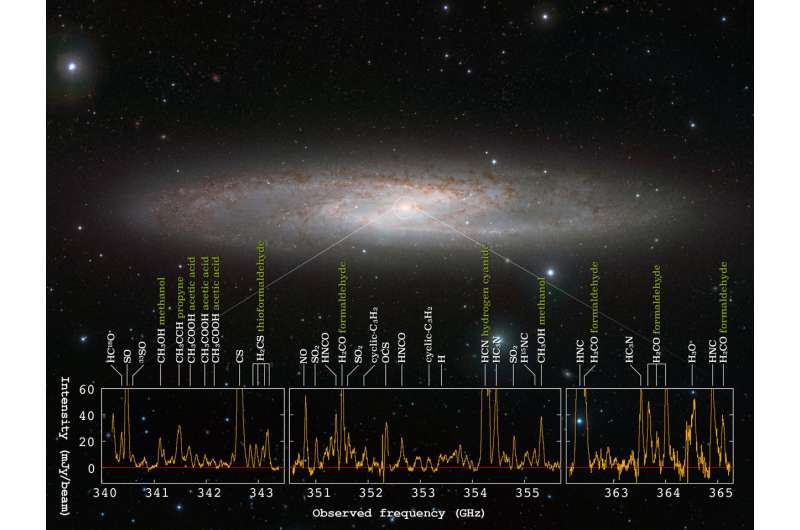Forest of molecular signals observed in star-forming galaxy

Ryo Ando, a graduate student of the University of Tokyo, and his colleagues have observed the galaxy NGC 253 and resolved its locations of star formation down to the scale of a molecular cloud, a star formation site with a size of about 30 light-years. As a result, they identified eight massive, dusty clouds aligned along the center of the galaxy.
"With its unprecedented resolution and sensitivity, ALMA showed us the detailed structure of the clouds," said Ando, the lead author of the research paper published in the Astrophysical Journal. "To my surprise, the gas clouds have a strong chemical individuality despite their similarity in size and mass."
Different molecules emit radio waves at different frequencies. Using this feature, the team investigated the chemical composition of the distant clouds by analyzing the radio signals precisely. They identified signals from various molecules including formaldehyde (H2CO), hydrogen cyanide (HCN), and many organic molecules.
One of the clouds exhibited an extremely rich chemical composition. The team identified footprints of 19 molecules in the cloud, including thioformaldehyde (H2CS), propyne (CH3CCH), and complex organic molecules including methanol (CH3OH) and acetic acid (CH3COOH). "The data are filled with the signals of various molecules," said Ando. "It is like a forest of molecules."
Many such "molecular forests" have been found in the Milky Way, but this is the first example observed in another galaxy. Researchers assume that the molecular jungle is an aggregate of dense, warm cocoons around bright baby stars. The cocoon gas is heated from inside by hundreds of young stars and a myriad of chemical reactions is driven to form various molecules.
Interestingly, the number of chemical signals is different between clouds. For example, another cloud among the eight has a very sparse chemical composition, even though it is located within dozens of light-years of the chemically rich cloud. Such a diversity of star forming clouds has never been seen before, and could be a key to understanding the starburst process in this galaxy.
NGC 253 is a prototypical active star-forming galaxy, or starburst galaxy. It is located 11 million light-years away in the constellation Sculptor. Starburst, or "baby boom" galaxies have been the major drivers of star formation and galaxy evolution throughout the whole history of the universe. Therefore, it is crucial to understand what is going on in the hearts of such galaxies.
Journal information: Astrophysical Journal
Provided by National Institutes of Natural Sciences



















